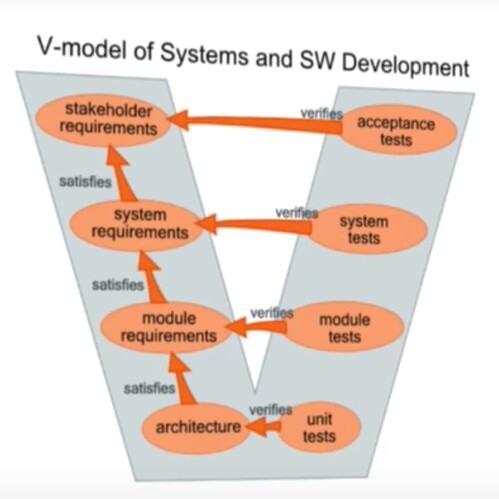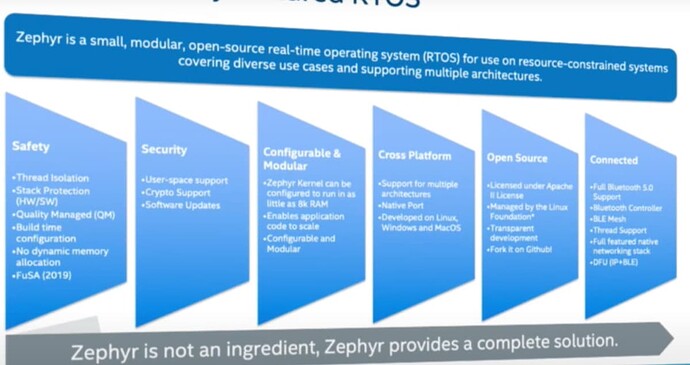See also:
- Zephyr in Safety Critical Applications - Zephyr Project
- Safety Working Group · zephyrproject-rtos/zephyr Wiki · GitHub
Notes:
- difficult to map a stereotypical open-source development to the V-model
- certification authority not familiar with open-source development
- V-model
- requires a lot of process and documentation
- need to start transforming your development model
- Quality Matters
- coverage, documentation, testing, test reports
- Quality is a foundation, base requirement
- Requirement Traceability
- Traceability Tools
- every line of code is connected to requirements, testing, test reports
- we don’t do in open source projects
- Currently used in Zephyr
- Doxygen
- tests
- requirements
- able to connect some of the requirements
- MISRA-C
- style guide
- focus in safety, security, portability, and reliability
- contains 167 + 14 guidelines
- a lot of rules make a lot of sense, but some are not well received
- having a consistent style helps with quality and readability
- opensource challenges
- MISRA-C is proprietary
- Most CI tools are commercial and not easy to integrate into Github/PRs
- Zephyr integrated check-patch from Linux kernel – give feedback about code immediately
- decide which parts of the code are important to you
- example of a controversial rule
- Rule 15.5 - a function should have a single point of exit at the end
- changing existing code structure adds risk
- Users demand Accountability
- Feature richness and completeness is not enough
- Main reason why adoption of open source is limited for higher safety integrity levels: “who is liable if something goes wrong?”
- How to approach certification in open-source
- Snapshot/branch
- getting supported feature set right up front
- every line of cost costs $150-$200
- Automate as much of the information tracking as you can
- Auto-generate documents from test and issue tracking systems
- The Ideal Project
- split development model
- Flexible open instance
- Auditable and controlled instance - branch with well defined scope developed with stricter rules and with an entity behind it
- SafeRTOS (FreeRTOS fork) did something similar, not quite
- was rebuilt and rewritten
- not the ideal model for open-source
- Zephyr wants to keep it OSS
- split development model
- Example: Regulating the Bazaar
- do we have the right set of reviewers?
- who gets to have the final say?
- how do we guarantee that the reviewer is aware of safety implications?
- for how long should changes be reviewed?
- Pull Request Processing Time
- wait at least a few days to merge code so it can be reviewed
- Contributions vs Reviews
- people like to contribute but not review
- Zephyr
- configure and modular
- helps define the scope for certification
- configure and modular
- Architecture and Key Features
- highly configurable, highly modular
- cooperative and pre-emptive threading
- memory and resources are typically statically allocated
- memory protection: stack overflow protection, kernel object and device driver permission tracking, thread issolation
- Roadmap
- limit scope
- robustness and operation safety
- mmu and mpu support
- tread isolation
- stack protection
- enhance and increase test coverage
- compliance with coding and style guidelines
- MISRA-C
- well defined and stable APIs
- Portability
- support POSIX APIs
- Scope for FuSA
- only kernel and core parts would be certified
- LTS release
- Summary
- functional safety and security requirements need to coexist with the open-source nature of the project
- quality needs to be driven on the project level
- manage developer and contributor expectations
- continue innovating on the main tree while hardening and stabalizing LTS
- need to officially establish accountability and trusted “entity”, ie with Certification Architect role of the project
- Q&A
- Q: was asked if Zephyr has been deployed into safety critical systems
- A: Yes, but I can’t talk about it, but confirmed there are already users in these applications.
- Zephyr is something you can innovate on instead of depending on 3rd party vendors/solutions.
- Q: how do you unittest the core features, interrupt handlers, etc.
- A: most of the testing is done a component level.
- Q: can you Zephyr on top of a certified hypevisor
- A: yes, that is possible


